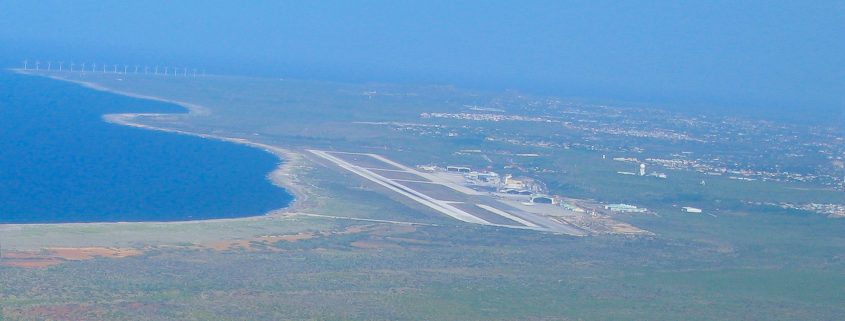Before plans to build two new wind parks off the coast of Curacao could be formalized, the Air Transport Safety Institute (NLR-ATSI) was commissioned to study the potential safety risks these wind parks posed to flight routes at HATO Airport and to determine if the wind turbines would interfere with local air traffic radar. Based on the findings of this comprehensive research, which was jointly conduced by TNO (Netherlands Organization for Applied Scientific Research), the Curacao aviation authorities agreed, on 11 February 2010, to permit the construction of the wind parks.
The new wind turbines , which have an 80-meter vertical axis and 90-meter wingspan , will replace the 15-year-old wind turbines at two existing wind parks. In late 2009, NuCapital, the owner of both wind parks, commissioned TNO and NLR-ATSI to study the possible consequences these wind turbines could have for air traffic radar, mid-air collisions and other potential eventualities. TNO recommended NLR-ATSI, an independent institute, for the project, thereby satisfying a precondition set by Maurice Adriaens, Curacao’s Minster of Transport, for independent research to be conducted. NLR-ATSI’s research specifically focused on whether the wind turbines impacted aviation safety and air traffic efficiency.
TNO studied the extent to which wind turbines affect radar services. NLR-ATSI then more specifically mapped the effects and findings of TNO’s research. To do this, NLR-ATSI studied if and how wind turbines affected the instrumental flight procedures and visual flight procedures at HATO Airport. In addition, NLR-ATSI studied how these wind turbines would ultimately impact the operations of the Air Traffic Control Services.
Part of NLR-ATSI’s research focused on determining the consequences that interference with radar signals could have for air traffic control operational duties, which is something the wind turbines could potentially impact. NLR provided expertise in the area of the possible operational ramifications for HATO Airport if signal interference did in fact occur. Wind turbines create a clutter effect in the signal of the Primary Surveillance Radar, and this can potentially disrupt the observation of aircraft in a certain sector of airspace. Because exposure to this clutter effect only occurs briefly and in a certain area, radar software can largely compensate for such occurrences, and hence it has a negligible effect on an air traffic controller’s operational duties.
The conclusion drawn from this research is that wind turbines do not affect the current instrument and visual procedures at HATO Airport. Wind turbines therefore have no adverse effect on the safety and efficiency of the present and future activities of HATO Airport.


